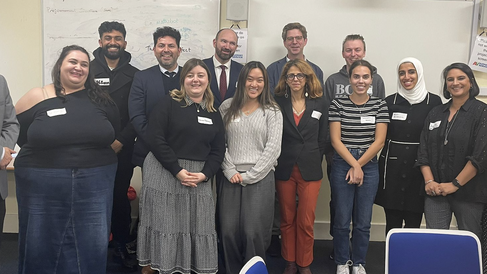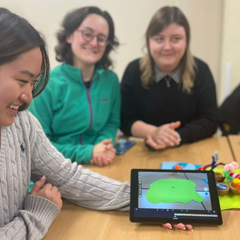
On 15 November, Dr Anastasia Badder & Dr Daniel Moulin convened a second annual joint symposium, Learning through the practice of dialogue. Held at Homerton College, the symposium aimed to consider what practices and techniques can be used to spark dialogue about and between religions.
The event incorporated a panel discussion on practices of dialogue and workshops introducing a practice of dialogue run by the The Faith & Belief Forum (faithbeliefforum.org) and Solutions Not Sides (solutionsnotsides.co.uk). The panel addressed questions such as what sparks meaningful dialogue, what kinds of learning can dialogue facilitate, and what are the limits of dialogue.
Guest speakers included Dr Ana Petrache (Pontifical University of St Thomas Aquinas), Arwa Hanif Al Qassim (University of Cambridge), Gabriel Alfaro (Universidad Rey Juan Carlos), Carrie Alderton (The Faith & Belief Forum) and Sharon Booth (Solutions Not Sides).
The event was attended by the Cambridge PGCE Religious Studies cohort, one of whom has provided the following reflection:
A good religious education
As a Religious Studies PGCE student, a central question I must consider throughout my training is: what comprises a good religious education?
Indeed, it is a question that is worth noting as it is an educator’s responsibility to ensure that what is being taught is informative and engaging. Granted, at times this can be challenging as there are some topics which will interest students and some which simply won’t.
The symposium began with a discussion on the nature of dialogue. This involved contemplating questions such as, “Is dialogue sufficient?” The dual senses of dialogue as “talk” and something undertaken “with a tradition” led to the observation that there are sub-distinctions within a tradition; and that dialogue can be considered as knowledge or an opinion.
The panel also discussed to what extent dialogue might be used to push people’s conceptions of knowledge of a particular subject. Dialogue (it was argued) works well with a good depth of knowledge, but also with a good interlocutor.
Shortcomings of dialogue
There were critical reflections on dialogue itself. Points which stood out most to me included how interreligious dialogue as a practice assumes that more talking is better. Perhaps it may be due to showing unity and respect for religious equality. Indeed, dialogical practices can be effective in some cases. However, there are limits.
It remains difficult for marginalised communities to participate, which prevents them from participating further. Further, dialogue may be structured around secular goals and/or an ideology. Also, dialogue could be a means towards colonial goals, a form of faith-washing to some extent. Lastly, and rather sceptically, dialogue may create more noise rather than actually solving things, as it presumes that everything has an answer & ignores other ways of people coming together to work together.
Meaningful dialogue
Meaningful dialogue can be a means to conflict resolution. Yet it needs a direction and purpose, namely, to offer solutions. Dialogue can spark curiosity and compassion, a desire to be educated and help. With that being said, there needs to be a willingness to be seen and heard to create opportunities to talk and share for genuine connections, luminous grounds if you will.
Overall, it is difficult to summarise how much was discussed in the symposium. The exploration of dialogue from numerous perspectives has enabled one to understand the value that dialogue has within the learning environment, while also considering its limitations. Abraham ben Meir ibn Ezra stated that “Words that come from the heart, enter the heart”. The symposium showcased this, as the panel offered many points which came from a place of warmth and academic curiosity. Thus, I must thank Dr Badder & Dr Moulin for organising the symposium because it has been extremely crucial towards my development as a practitioner and the knowledge gained from it has been invaluable.
—Kian Saber, PGCE student, 2024–2025
Images: above: group photo of symposium participants; below: PGCE students creating a stop motion animation film (The Faith & Belief Forum, 2024).

